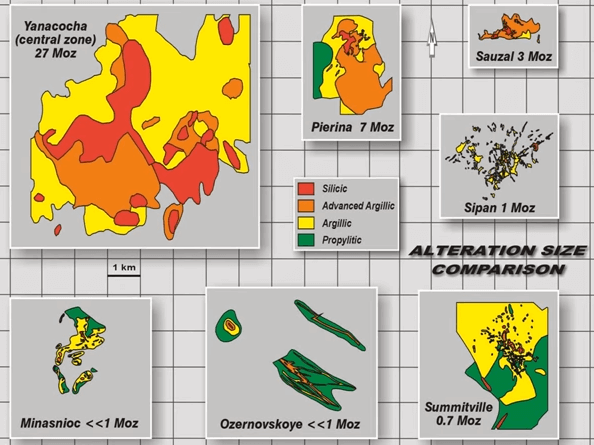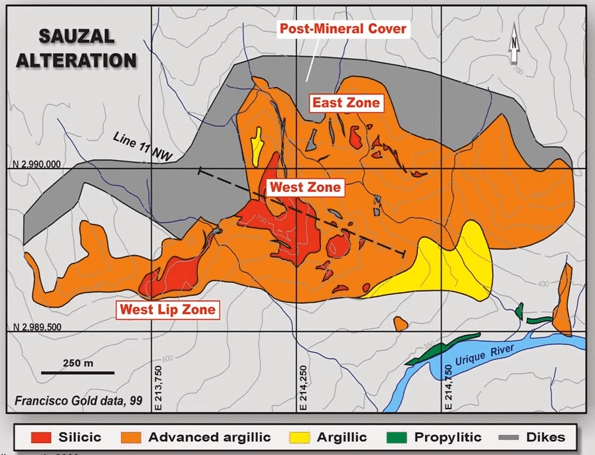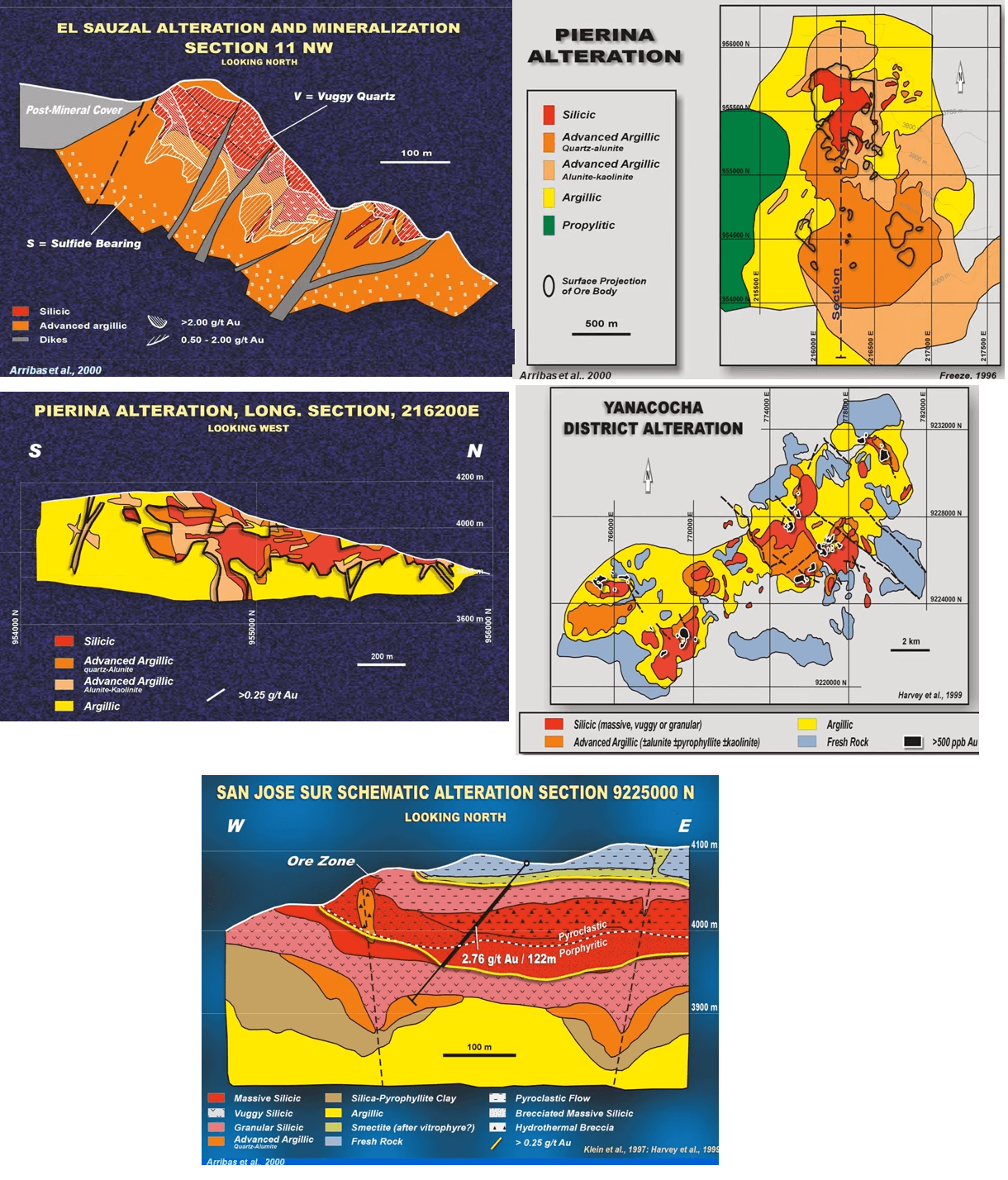 High Sulphidation Epithermal Gold Deposits form in geothermal systems where hot acidic hydrothermal fluid directly from the intrusion, remains undiluted by ground water. Low sulfidation deposits on the other hand from a geothermal system in which the magmatic fluid is cooled and diluted by groundwater and the pH is neutralized at depth. The formation of epithermal deposits is all about dropping the gold from solution before it reaches the surface and escapes to the atmosphere or hydrosphere. How does these position occurs varies according to weather the gold is being carried by hot acid fluid or cooler neutral fluids.
High Sulphidation Epithermal Gold Deposits form in geothermal systems where hot acidic hydrothermal fluid directly from the intrusion, remains undiluted by ground water. Low sulfidation deposits on the other hand from a geothermal system in which the magmatic fluid is cooled and diluted by groundwater and the pH is neutralized at depth. The formation of epithermal deposits is all about dropping the gold from solution before it reaches the surface and escapes to the atmosphere or hydrosphere. How does these position occurs varies according to weather the gold is being carried by hot acid fluid or cooler neutral fluids.
First let’s look at the high sulfidation epithermal with a hot acid hydrothermal fluids. This is an aerial view of a typical bleach high grounds sulfidation alteration zone in the Chilean Andes. In high sulfidation deposits the mineralization is a two – stage process; initial alteration followed by all mineralization itself. 
The image show the alterations stage, with hot acid fluids, sometimes vaporized, rising above the source intrusion and attacking the country rock as it passes on its way to the surface, the rock is progressively leached and altered so the at the feldspars break down to clays. These clays are then removed leaving only a silica sponge which is impervious to hydrochloric or sulfuric acid.  The silica remnant is often refereed to vuggy silica and muggy quartz or lit cape.
The silica remnant is often refereed to vuggy silica and muggy quartz or lit cape.
The second and third image show the deposition of the gold, this often occurs in two phases again: an initial gaseous transport of the gold and then as the system cools the gold comes up in liquid phase. In many cases we don’t get the second stage and we end up with a barren leach litscape of advanced altered rock. Here’s another cartoon of the same process but showing how the shape of the plume and alteration and the mineralization may be affected by local geology and groundwater pathways. Without getting too deep into the mineralogy, a geologists will talk about alunite.
Without getting too deep into the mineralogy, a geologists will talk about alunite.

Alunite is a pink alteration of feldspar and it indicates that the fluid were highly acid. Its presence is indicative of a high sulfidation epithermal system.  Active high sulfidation hot springs, are not places you would like to swim, they’re acid and they stink of rotten eggs on hydrogen sulphide and because the acid breaks down into feldspar; breaks down the feldspar to clay, they usually consist of more mud than of water. But how do you know when you are standing on an extinct high sulfidation epithermal system? The obvious diagnostic features, are the presence of vuggy quartz an abundance of white clays and the minerals: alunite and jarosite, which tells us that the fluids were highly acidic and lack of obvious veins, because in these deposits fluid flowing relies on the porosity that the acid leaching imposed on the host rocks rather than on faults.
Active high sulfidation hot springs, are not places you would like to swim, they’re acid and they stink of rotten eggs on hydrogen sulphide and because the acid breaks down into feldspar; breaks down the feldspar to clay, they usually consist of more mud than of water. But how do you know when you are standing on an extinct high sulfidation epithermal system? The obvious diagnostic features, are the presence of vuggy quartz an abundance of white clays and the minerals: alunite and jarosite, which tells us that the fluids were highly acidic and lack of obvious veins, because in these deposits fluid flowing relies on the porosity that the acid leaching imposed on the host rocks rather than on faults.
Due to the disseminated Saleh mineralization high sulfidation deposits are generally mined as open pits. Well- known high sulfidation epithermal include:
- Goldcrop- El Sauzal in Mexico,
- Barrick’s – Pierina in Peru
- Newmont- Yanacocha both in Peru.
This is an old photo of El Sauzal looking south, before they started the mining. The vuggy silica makes up the cliffs due to its hardness and resistance to erosion, the light colour of the drill rows is due to the white clay in the clay alteration. In this plan view of the same deposit, the mineralized silica is shown in red, and the clay alteration is in orange and in yellow. In section, the vuggy silica in red can be seen to have developed in a gently dipping, favourable horizon in the volcanic stratigraphy. At Pierina in Peru, you can clearly see the association of the gold, which is the heavy black lines on the image, with the silicic alteration in red although it also extends out into the advanced argillic in orange. In this section of Pierina you can again see the way that the alteration has followed a sub horizontal favourable stratigraphic horizon.
This is the alteration map of the Yanacocha district, the mother of all high sulfidation deposits. The alteration system is 16 km across and covers over 50 square kilometres. And again Newmont Yanacocha is a combination of both flat stratigraphic controls and steep structural controls to the silica alteration.
Does the size of an alteration zone reflect the size of the gold deposit: It looks like having a large advanced argillic zone is a necessity for significant mineralization, but not all big alteration zones have gold, probable because they went through the leaching phase but not the later mineralizing phase, this is critical to keep in mind when reading press releases which extols fixed intercepts of vuggy silica they can still be completely barren.
Ok, enough on the high sulfidation systems, let’s look now at the other end of the spectrum, the low sulfidation epithermal deposits.



